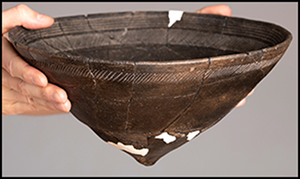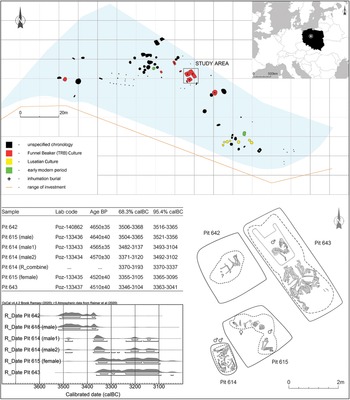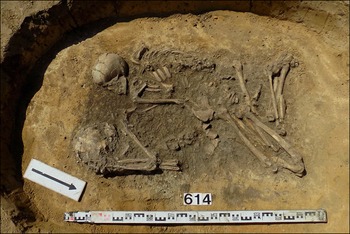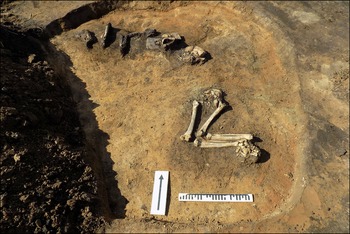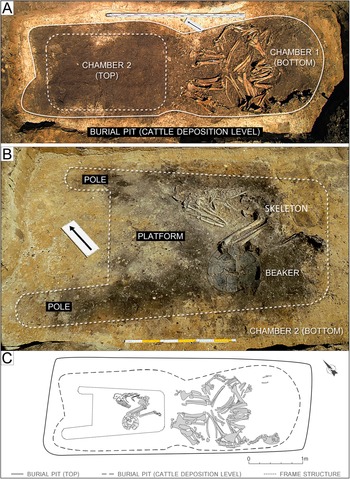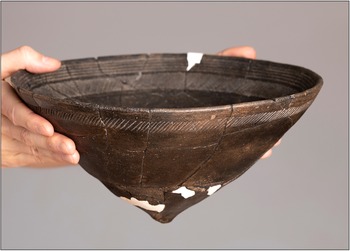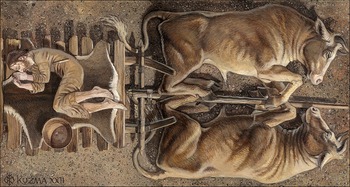Background
In 2018, rescue excavations in the village of Markowice in central Poland (Mogilno district, Kuyavian-Pomeranian province) yielded 82 features containing 440 potsherds, 1473 fragments of human bone, 365 animal bones and other archaeological records that provide evidence for both funerary and domestic activities at the site during an extended timescale spanning the Late Neolithic to the early modern period (c. 3650 BC to AD 1800) (Figure 1).

Figure 1. Plan of site 12 at Markowice, central Poland, with a close-up of the Funnel Beaker (TRB) burial pits forming a distinct cluster and radiocarbon dates for human bones from the pits. All dates calibrated in OxCal v4.4.2 (Bronk Ramsey Reference Bronk Ramsey2009), using the IntCal20 calibration curve (Reimer et al. Reference Reimer2020) (site plan and drawings by P. Zawilski and Ł. Kowalski; radiocarbon data based on reports by T. Goslar).
The earliest occupation level recorded in Markowice can be dated by ceramic typology to as early as the mid fourth millennium BC and can be linked to people of the Funnel Beaker (TRB) Culture. Evidence of their mortuary practices has been exposed over a substantial portion of the site and can be attested to by no less than nine archaeological features, including seven human inhumations and a few accompanying pits that could have been used during rituals performed at the time of burial or later. The fieldwork identified a distinct cluster of four graves situated in the central part of the northern area of the site, while three further graves were found in close proximity to the burial cluster. No other archaeological features and structures were recorded to suggest that Late Neolithic habitation took place at the site, rendering it one of the most important burial sites of the later TRB period in Poland. More specifically, the site of Markowice offers a new case study for exploring aspects of the Baden Culture package uptake in the region, with a particular view to mortuary treatments (Midgley Reference Midgley1992; Sherratt Reference Sherratt1997; Furholt Reference Furholt2008; Furholt et al. Reference Furholt, Szmyt and Zastawny2008).
Preliminary archaeological findings
The stratigraphic evidence from the site indicates that three of the graves that form the burial cluster (features 615, 642 and 643) could have been framed in their upper sections with a type of timber pallet, which may explain the sharp and angular boundaries of these features. Notably, similar grave constructions are apparent in the Baden cemetery in Tatabánya–Delphi, Hungary (Horváth et al. Reference Horváth2020). The tight arrangement of the cluster is notable (Figure 1), particularly when compared with the radiocarbon dates of two neighbouring burial pits (642 and 643), which do not overlap at 95.4% confidence. Bayesian modelling of the timing between these two events, however, pushes them into a uniform-phase model (3510/3350–3370/3190 BC at 68.3%).
Radiocarbon dates obtained for the two adjacent double interments are equally surprising (Figures 2 & 3), particularly pit grave 615, the flexed burial of an adult male who received a female companion at a later date. A χ2-test was used to check if the radiocarbon data from grave 615 can be merged, but the resulting confidence level drops below 5%, making it the first known example of a secondary TRB interment in Poland, although comparable double Baden Culture burials are known in Austria and Hungary (Horváth et al. Reference Horváth2020).
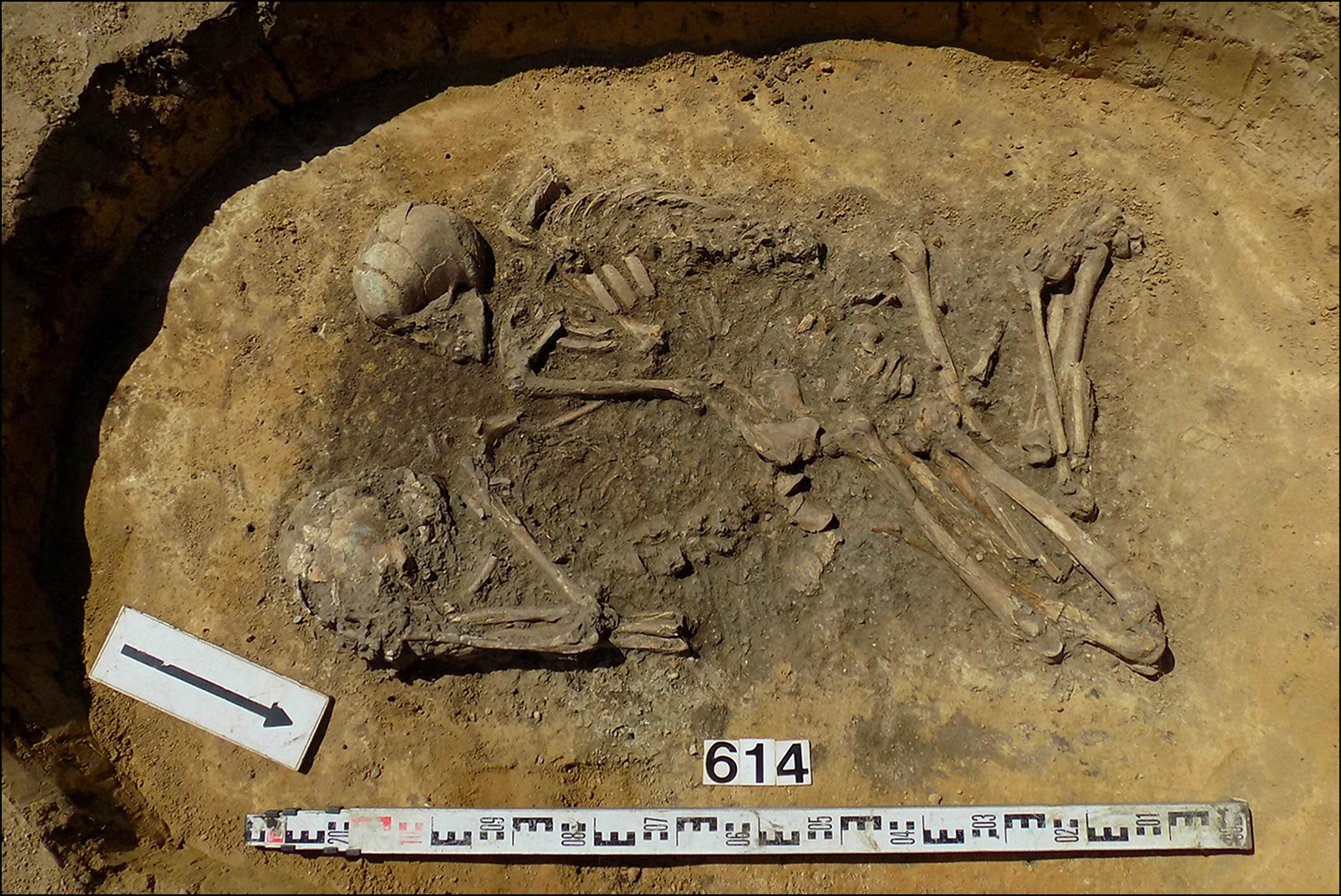
Figure 2. In situ view of pit 614 at Markowice, identified as the joint burial of two adult men (photograph by M. Popińska and M. Biskup).
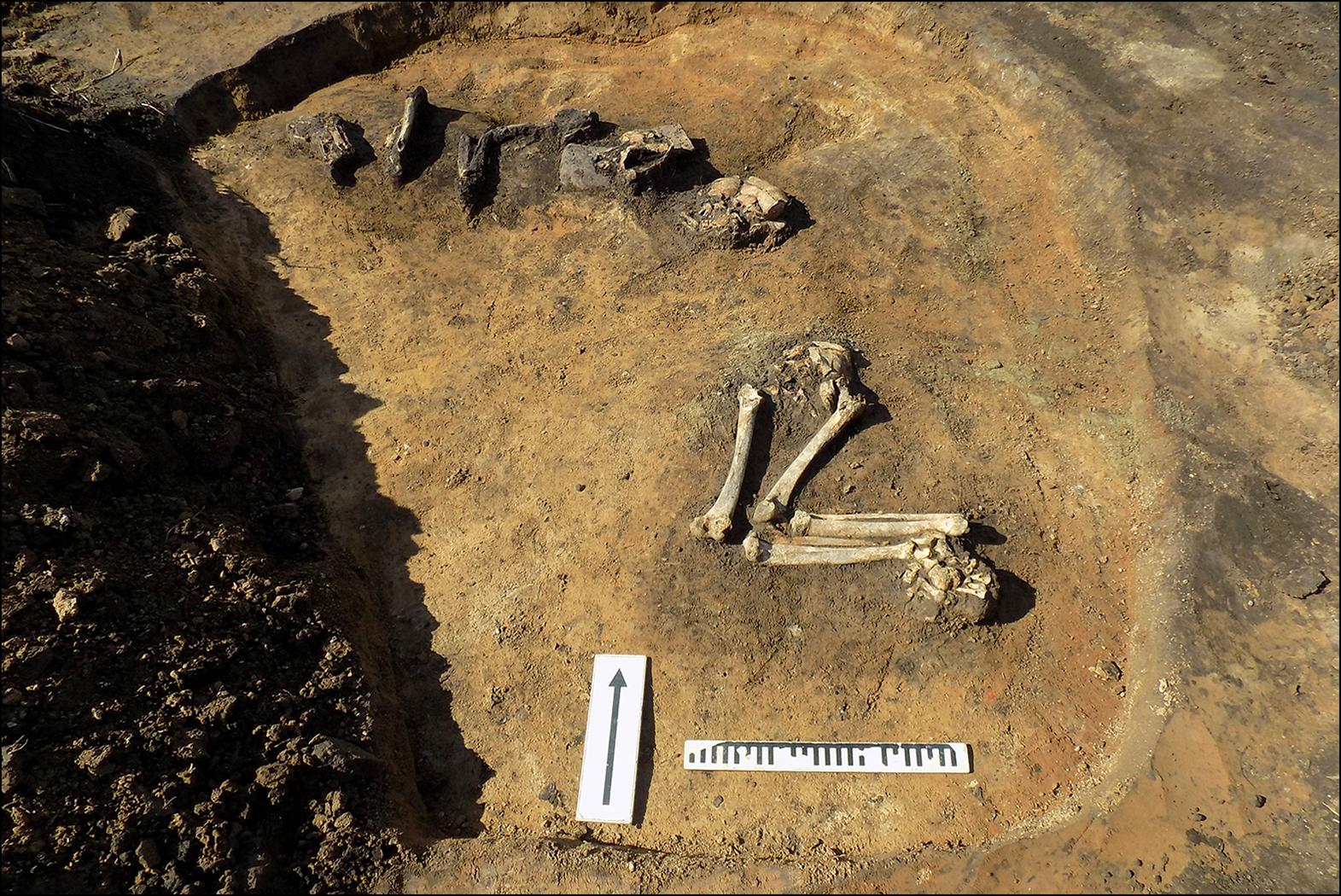
Figure 3. In situ view of pit 615 at Markowice, identified as the double burial of an adult man and woman (photograph by M. Popińska and M. Biskup). The body of the man was interred first in the pit grave and received a female companion at a later date (see text for further details).
The mortuary treatment evident at Markowice also indicates that flexed or crouched burial was a prescribed funeral custom, which also required placing males on their right side and females on their left. These mortuary customs contrast with the funerary status quo of the TRB era in Poland (i.e. deceased individuals were buried in a prone position) and are yet another Baden cultural expression in the region.
The most telling archaeological evidence of Baden Culture influence in the region is feature 643—the burial of a young male along with two cattle, dating to 3346–3104 BC at 68.3% (Figure 4). The grave comprised a rectangular pit measuring 4.9m in length, 1.8m in width and approximately 0.45m deep. The body of the man (aged 18–20 years) was placed on his right side with knees slightly bent, slightly deeper than the two mature (2.5–3-year-old) cattle, which could have formed a pair of draught animals (Figure 4a). The grave contained a complete wide-mouthed beaker with a pointed bottom (Figure 5)—a signature mark of late TRB pottery-making, which testifies to the spread of Luboń-style pottery in the region of central-western Poland (Jażdżewski Reference Jażdżewski1936). Other grave offerings included a double point made of bone, two flint artefacts and more than 150 fragments of broken storage and serving wares scattered across the grave chamber, along with the bones of wild and domestic animals that can be interpreted as food debris from a funeral feast accompanying the burial.

Figure 4. In situ view of pit 643 at Markowice, identified as the joint burial of a young male and two cattle drawing an unwheeled funerary vehicle (photographs by M. Popińska and M. Biskup; C by Ł. Kowalski and P. Zawilski).

Figure 5. A wide-mouthed beaker with a pointed bottom recovered from pit 643 at Markowice, accompanying the male burial with cattle (photograph by W. Ochotny).
There were soil marks from a decayed 1.8 × 0.9m platform mounted on two long poles (Figure 4b–c), which was interred with the male. In situ observations confirmed that no archaeological material or structures in feature 643 could be interpreted as wheels accompanying the frame structure, negating the possibility that a cart or wagon was deposited along with the dead body. Rather, the structure is likely to represent some type of unwheeled vehicle (sledge or travois) pulled by cattle (Figure 6). As such, the discovery made at Markowice proves to be the first recognised joint burial of human and cattle in the geohistorical range of the TRB, and one that can be added to the corpus of evidence for animal traction in Late Neolithic Europe (Bakker et al. Reference Bakker, Kruk, Lanting and Milisauskas1999; Mischka Reference Mischka2011). The arrangement of grave 643, reflecting the idea of animal traction, adheres well to the Baden funeral rite observed in the Carpathian Basin (Horváth Reference Horváth2019) and has little, if any, connection to the ritual killing and burial of cattle known from the contemporaneous Globular Amphora Culture of Central Europe (see, for example, Furholt et al. Reference Furholt, Szmyt and Zastawny2008).

Figure 6. Hypothetical reconstruction of the Funnel Beaker (TRB) human-animal burial uncovered at Markowice (by M. Kuźma).
Significance and future work
The preliminary results from the site of Markowice provide a valuable insight into the funeral customs of the late TRB people in Poland and their response to the socio-economic developments of the era. Future research will address questions about diet and human mobility, as well as the life histories of the buried individuals. Priority will be given to genetic and biogeochemical analyses to establish kinship connections and geographic origins, particularly regarding the double interments discovered at the site. Additional radiocarbon dating is required to refine the site's chronology, targeting particularly the diachronic spatial organisation of the burials. These combined analyses are expected to provide a more detailed picture of the burial site at Markowice, which will refine our understanding of the Baden Culture uptake in the region of northern Poland.
Funding statement
This work was supported by Nicolaus Copernicus University in Toruń under the University Centre of Excellence programme.


